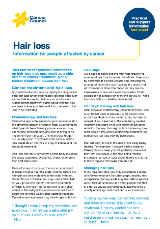Hair loss
Whether you lose your hair will depend on the drugs prescribed. Some people lose all their hair (alopecia); others find it becomes thinner or they may lose only a little hair. Some people lose none at all. Although losing hair from the head is most common, eyebrows, eyelashes, hair from your underarms, legs, chest, beard and pubic area can also fall out.
Learn more about:
What to expect
When hair loss does occur, it usually starts during cycle 2 or 3 – or sometimes after the first cycle. It may be sudden or happen gradually. Before and while your hair is falling out, your scalp may feel hot, itchy, tender or tingly. Some people find that the skin on their head is extra sensitive, and they may develop pimples on their scalp.
It’s not unusual to feel sad or less confident. It may take time to adjust to how you look, then more time to feel good about yourself again.
Hair growing back
After treatment ends, it can take 4–12 months to grow back a full head of hair. When your hair first grows back, it may be a different colour, softer or curly (even if you have always had straight hair). In time, your hair usually returns to its original condition.
Scalp cooling
Some treatment centres provide cold caps, which may reduce hair loss from the head. Cold caps can only be used with certain drugs and some types of cancer, and they don’t always stop hair loss.
Worn while chemotherapy is being given, the cap is attached to a cooling unit. This reduces blood flow and the amount of chemotherapy drug that reaches the scalp. Some people find the cold cap uncomfortable, and the cold temperature may be painful. If you are interested in trying a cold cap, ask your treatment centre if it is an option for you.
Ways to manage hair loss
- Keep your hair and scalp very clean. Use a mild shampoo like baby shampoo. If you want to use moisturiser on your head, use sorbolene. Check with your nurse before using any other hair or skin care products on the scalp.
- Comb or brush your hair gently with a wide tooth comb or a hairbrush with soft bristles.
- Explain to family and friends, especially children, that the chemotherapy may make your hair fall out.
- Consider cutting your hair before it falls out. Some people say this gives them a sense of control.
- Wear a wig, hat, turban or scarf, or go bare-headed – whatever feels best to you. If you prefer to leave your head bare, protect it from the sun and the cold.
- If you plan to wear a wig, choose it before treatment starts so you can match your own hair colour and style. Or consider a new style or colour for a bit of fun.
- Some treatment centres have wig loan services; call Cancer Council 13 11 20 for more information.
- Try using a pillowcase made from silk, satin or bamboo as these smooth fabrics can decrease hair tangles.
- Avoid dyeing your hair during chemotherapy and for about 6 months afterwards to allow the hair to become stronger. Vegetable-based hair dyes may be gentler on the hair and scalp.
- If your eyelashes fall out, wear sunglasses outside to protect your eyes from dust and sunlight.
- If your eyebrows fall out, you may wish to wear reusable eyebrow wigs or transfers until they grow back.
- Contact Look Good Feel Better on 1800 650 960 – this program helps people manage the appearance-related effects of cancer treatment.
For more on this, see Hair loss.
→ READ MORE: Appetite changes, nausea or vomiting
Podcast: Coping with a Cancer Diagnosis
Listen to more of our podcast for people affected by cancer
A/Prof Kate Mahon, Director of Medical Oncology, Chris O’Brien Lifehouse, NSW; Katherine Bell, Dietetics Department, Liverpool Hospital, NSW; Brigitta Leben, Dietetics Department, Liverpool Hospital, NSW; Sophie Michele, 13 11 20 Consultant, Cancer Council SA; Dr Jess Smith, Medical Oncologist, Macquarie University Hospital, NSW; Karene Stewart, Consumer; Julie Teraci, Clinical Nurse Consultant, Skin Cancer and Melanoma, Cancer Network WA.
View the Cancer Council NSW editorial policy.
View all publications or call 13 11 20 for free printed copies.
